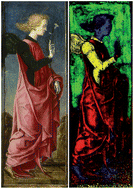Mapping of egg yolk and animal skin glue paint binders in Early Renaissance paintings using near infrared reflectance imaging spectroscopy
Abstract
In situ

- This article is part of the themed collection: Molecular Analysis for Art, Archaeometry and Conservation

 Please wait while we load your content...
Please wait while we load your content...